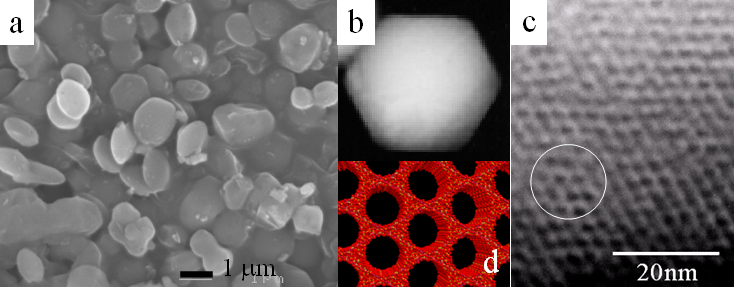Mesoporous Silica Adsorbents and Membranes
(June 1999 - present)
The mesoporous MCM-41 has straight pore channels arranged in a regular, hexagonal pattern. The pore wall consists of thin shell of amorphous silica. Our research interest is to study the effects of the pore size and chemistry on the adsorption and separation properties of mesoporous silica adsorbents and membranes. Direct manipulation of the pore size is achieved through the use of organic solvent as swelling agent during the material synthesis. Different chemical moieties are grafted onto the pore wall to alter its chemical affinity and adsorption property. Using this process, adsorbents and membranes with specific affinity for a targeted chemical functionality (i.e., R-CH3, R-COOH) were prepared. Membrane prepared using mesoporous silica [17] exhibits tunable separation properties that can be useful in many industrial and pharmaceutical separations.

This research is conducted in collaboration with experts in adsorption processes and modeling:
· Dr. King Lun Yeung (Chemical Engineering, HKUST) is responsible for the material synthesis, modification, characterization and testing of the modified mesoporous silica adsorbent and membranes.
· Prof. Gordon McKay (Chemical Engineering, HKUST) is a well-known expert in adsorption and his participation is essential for the success of this project.
· Dr. David Hui (Chemical Engineering, HKUST) is a modeling expert and has extensive industrial experience. He is responsible for the process modeling, optimization and scale-up of the adsorption and membrane unit utilizing these new materials.
1. HKUST6037/00P Environmental applications of mesoporous silica with engineered pore structure and tailored chemistry.
PRINCIPAL INVESTIGATOR: King Lun Yeung
STATUS: On-going (September 2000 - present)
SUMMARY: Chemically modified mesoporous silica (MCM41) was synthesized and tested for selective adsorption and removal of organic pollutants from aqueous solution. The adsorption capacity at equilibrium was determined and used to fine-tune the design of the adsorbent material to achieve optimum performance.
Students: (1Ph.D. student, 1 M.Sc. student, 4 undergraduate students)
· Ms. Carolina Y. K. Ng (Jr. R.A., June - August 1998)
· Ms. Prudence P. S. Lau (part time Jr. R.A., September, 1998 - May, 1999)
· Mr. Leo W. K. Cheung (UG student (CENG 398), June-August, 1999, part time Jr. R.A., September - December, 1999)
· Ms. Alice K. Y. Ho (M.Sc. Student, January, 2001 - January, 2002, R.A. February - August, 2002 )
· Mr. Lawrence W. T. Wong (UG student (CENG 398), January - August, 2002)
· Mr. Louis K. F. Lam (Ph.D. Student, September, 2002 - Present)
Publications and Presentations: (1 peer-reviewed journal manuscript, 4 presentations)
1. K.Y. Ho, G. McKay and K.L. Yeung, "Selective adsorbents from ordered mesoporous silica,"Langmuir 19 (2003) 3019-3024. PDF file
Conferences and Invited Talks:
1. K.Y. Ho, K.L. Yeung, G. McKay and D.C.W. Hui, “Adsorption and separation properties of chemically modified ordered mesoporous silica (OMS) materials,” ISCRE-17 at Hong Kong, August 25-28, 2002.
2. K.F. Lam, K.L. Yeung and G. McKay, "Selective adsorption of Cu and Pb in ordered mesoporous silica adsorbents" AIChE 2003 at San Francisco, USA, November 15-21, 2003.
3. K.F. Lam, K.L. Yeung and G. McKay, "Separation of copper and lead using selective ordered mesoporous silica adsorbents," 2003 MRS Fall Meeting at Boston, USA, December 1-5, 2003.
4. K.F. Lam, K.Y. Ho, K.L. Yeung and G. McKay, "Selective adsorbents from chemically modified ordered mesoporous silica," IZC-14 at Cape Town, South Africa, April 25-30, 2004.